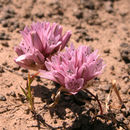en
names in breadcrumbs


Allium parvum is an American species of wild onion known by the common name small onion.[4][5] It is native to the western United States where it is a common member of the flora in rocky, dry areas in mountainous areas, especially in talus at elevations of 1,200–2,800 m (3,900–9,200 ft). It is widespread in California, Nevada, Oregon and Idaho, and also reported from western Utah and from extreme southwestern Montana (Ravalli and Beaverhead Counties)[6][7][8]
Allium parvum has a bulb one to two and a half centimeters wide and bears a relatively short scape for an onion species, rarely more than 12 centimeters tall. The two leaves are sickle-shaped. Atop the stem is an umbel of fewer than 30 flowers, which are generally pale pink with prominent dark midveins. Anthers are purple or yellow; pollen yellow.[5][9][10][11][12]
This plant was a food and flavoring for the Paiute people.[13][14]
Allium parvum is an American species of wild onion known by the common name small onion. It is native to the western United States where it is a common member of the flora in rocky, dry areas in mountainous areas, especially in talus at elevations of 1,200–2,800 m (3,900–9,200 ft). It is widespread in California, Nevada, Oregon and Idaho, and also reported from western Utah and from extreme southwestern Montana (Ravalli and Beaverhead Counties)
Allium parvum has a bulb one to two and a half centimeters wide and bears a relatively short scape for an onion species, rarely more than 12 centimeters tall. The two leaves are sickle-shaped. Atop the stem is an umbel of fewer than 30 flowers, which are generally pale pink with prominent dark midveins. Anthers are purple or yellow; pollen yellow.